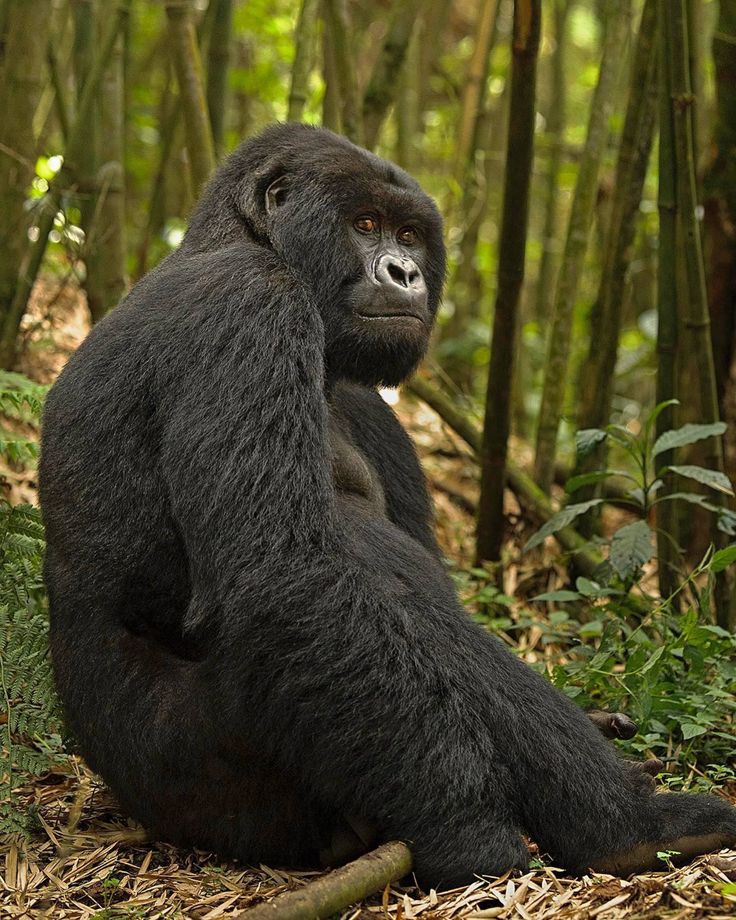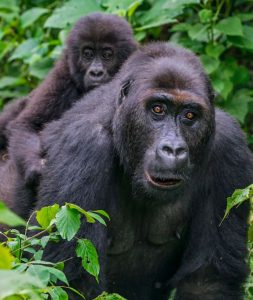Are Mountain Gorillas Dangerous to Humans?
Are Mountain Gorillas Dangerous to Humans? Mountain gorillas are often referred to as gentle giants, known for their peaceful demeanor and tight family bonds. Found in the dense forests of East and Central Africa, these magnificent creatures are a highlight for wildlife enthusiasts who visit Uganda, Rwanda, and the Democratic Republic of Congo. However, a common question arises: Are mountain gorillas dangerous to humans?
The short answer is that mountain gorillas are not naturally dangerous to humans, but they are wild animals and can become defensive if they feel threatened. Understanding their behavior, the risks involved, and the proper guidelines can ensure a safe and unforgettable gorilla trekking experience. Let’s dive into the details.
The Nature of Mountain Gorillas
Mountain gorillas are gentle and social animals. They live in family groups called troops, which are typically composed of one dominant male (the silverback), several females, and their offspring. Their behavior reflects their peaceful lifestyle and strong familial bonds.
1. Gentle Giants
Despite their size and strength—adult males can weigh up to 440 pounds—mountain gorillas are primarily herbivores. They spend most of their time foraging, eating leaves, fruit, and bamboo shoots. Aggression is not a common trait unless they feel their family or territory is under threat.
2. Strong Family Bonds
Mountain gorillas are incredibly social and protective of their family units. The silverback acts as the leader, providing protection and resolving conflicts within the group. Their interactions are often characterized by grooming and nurturing, showing their peaceful disposition.
3. Non-Aggressive Behavior
In their natural environment, mountain gorillas avoid conflict. Their primary goal is survival, which often involves avoiding unnecessary risks, including confrontations. They use body language and vocalizations to communicate, warning others of their intentions.
Are Mountain Gorillas Ever Dangerous?
Although mountain gorillas are generally peaceful, certain situations can trigger defensive behavior. These scenarios are rare but important to understand.
1. Feeling Threatened
Mountain gorillas may perceive humans as a threat if approached too closely or too suddenly. This is especially true for a silverback, whose primary responsibility is to protect the troop. If the group feels cornered or unsafe, the silverback may charge as a warning.
2. Provocation
Human behavior, whether intentional or accidental, can provoke gorillas. Sudden movements, loud noises, or direct eye contact can be interpreted as aggression. Visitors who fail to follow guidelines risk triggering a defensive response.
3. Protecting Their Young
Like most animals, mountain gorillas are protective of their young. If they sense danger to their infants, they may act defensively. This is why it’s crucial to keep a respectful distance during trekking.
4. Territorial Defense
In rare cases, mountain gorillas may become defensive if they perceive their territory is being invaded. This is more likely to happen with unhabituated gorillas, which are not accustomed to human presence.
5. Illness or Stress
Sick or stressed gorillas may behave unpredictably. Because they share 98% of their DNA with humans, gorillas are susceptible to some human diseases. Conservation teams closely monitor their health to minimize risks.
Safety Measures for Gorilla Trekking
When trekking to see mountain gorillas, safety is a top priority. Following established guidelines ensures both your safety and the well-being of the gorillas.
1. Maintain a Safe Distance
Visitors are required to keep a distance of at least 7 meters (23 feet) from the gorillas. This rule protects the animals from stress and reduces the risk of disease transmission.
2. Follow Your Guide’s Instructions
Every trekking group is accompanied by trained rangers and guides. They are experts in gorilla behavior and know how to manage interactions. Always follow their advice to avoid unintended risks.
3. Move Slowly and Quietly
Gorillas are sensitive to noise and sudden movements. Speak softly, avoid abrupt gestures, and move calmly to ensure a peaceful encounter.
4. Avoid Direct Eye Contact
While it’s tempting to lock eyes with these majestic animals, direct eye contact can be seen as a challenge. Instead, look at them from the side or downward.
5. Stay Healthy
Visitors with illnesses like colds or flu are not allowed to trek. This rule protects the gorillas from contracting human diseases, which can be fatal to them.
6. Avoid Touching or Feeding Gorillas
Human contact disrupts gorillas’ natural behavior and can make them reliant on humans. Feeding is strictly prohibited, as it could also expose them to harmful substances.
The Role of Habituation in Safe Trekking
Most gorillas encountered during trekking have undergone a process called habituation. This is a gradual and careful introduction of gorillas to human presence, making them less likely to react defensively.
1. What is Habituation?
Habituation is a process that takes months or even years, during which researchers and conservationists spend time with gorillas daily. The goal is to help the gorillas become accustomed to humans without feeling threatened.
2. Benefits of Habituation
- It ensures a calm and safe experience for trekkers.
- It minimizes stress for the gorillas.
- It allows researchers to monitor gorilla health and behavior.
What to Do If a Gorilla Becomes Aggressive
Although rare, there may be situations where a gorilla displays aggression, such as a bluff charge. Here’s how to respond:
1. Stay Calm
Running or panicking can escalate the situation. Instead, remain still and composed.
2. Crouch Down
Lowering your body makes you appear less threatening. Avoid standing tall or making yourself look bigger.
3. Follow the Guide’s Lead
Guides are trained to de-escalate such situations. They may instruct you to move slowly away or remain still.
4. Avoid Eye Contact
Continue to avert your gaze and avoid direct eye contact.
Are Mountain Gorillas More Dangerous Than Other Animals?
Compared to other large wildlife species in Africa, mountain gorillas are relatively safe. Here’s a comparison:
- Lions and Leopards: Predators by nature, they pose a higher risk during safaris.
- Elephants: Known for their unpredictable behavior, especially when protecting calves.
- Hippos: Responsible for more human fatalities in Africa than any other large animal due to their territorial instincts.
In contrast, mountain gorillas are herbivores with no natural inclination to attack unless provoked.
The Importance of Conservation
Mountain gorillas are critically endangered, with fewer than 1,100 individuals left in the wild. Trekking programs play a vital role in their conservation, as funds from permits go directly toward protecting their habitats, funding anti-poaching efforts, and supporting local communities.
Conclusion
Mountain gorillas are not inherently dangerous to humans. Their gentle nature and habituation make them some of the most peaceful animals to observe in the wild. However, they are still wild creatures, and respecting their boundaries is crucial to ensure safety.
By following guidelines, staying calm, and understanding their behavior, visitors can enjoy unforgettable encounters with these magnificent primates. These experiences not only provide insight into the lives of mountain gorillas but also contribute to their ongoing conservation. Treating them with respect ensures their survival and the preservation of one of nature’s most remarkable species.




